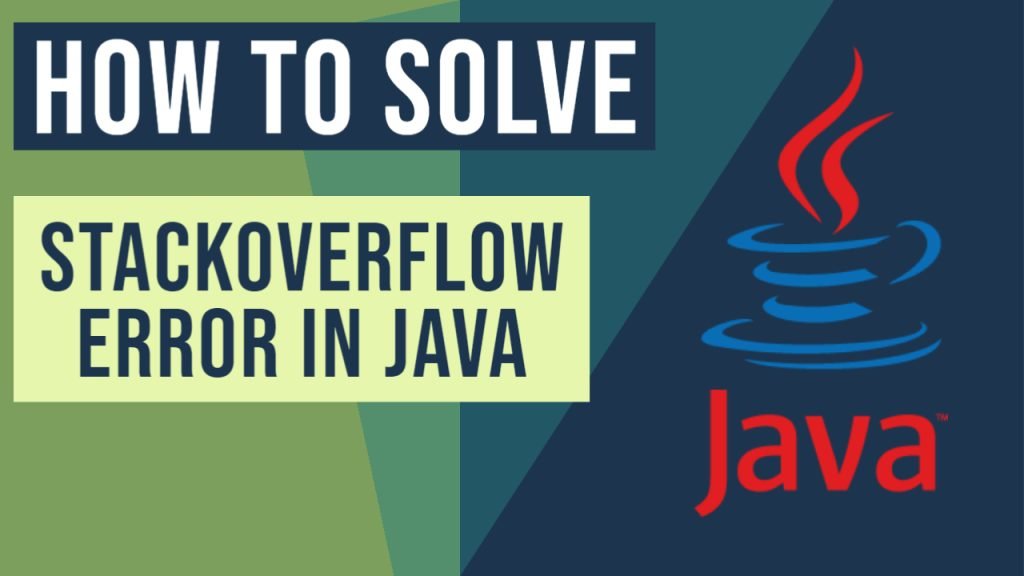java.lang.StackOverflowError – How to solve StackOverflowError
The java.lang.stackoverflowerror – StackOverflow Error in Java is thrown to indicate that the application’s stack was exhausted, due to deep recursion.
The StackOverflowError extends the VirtualMachineError class, which indicates that the JVM is broken, or it has run out of resources and cannot operate. Furthermore, the VirtualMachineError extends the Error class, which is used to indicate those serious problems that an application should not catch. A method may not declare such errors in its throw clause, because these errors are abnormal conditions that shall never occur.
Finally, the StackOverflowError exists since the 1.0 version of Java.
You can also check this tutorial in the following video:
1. The Structure of StackOverflowError
Constructors
StackOverflowError()
Creates an instance of the StackOverflowError class, setting null as its message.
StackOverflowError(String s)
Creates an instance of the StackOverflowError class, using the specified string as message. The string argument indicates the name of the class that threw the error.
2. The StackOverflowError in Java
When a function call is invoked by a Java application, a stack frame is allocated on the call stack. The stack frame contains the parameters of the invoked method, its local parameters, and the return address of the method. The return address denotes the execution point from which, the program execution shall continue after the invoked method returns. If there is no space for a new stack frame then, the StackOverflowError is thrown by the Java Virtual Machine (JVM).

The most common case that can possibly exhaust a Java application’s stack is recursion. In recursion, a method invokes itself during its execution. Recursion is considered as a powerful general-purpose programming technique, but must be used with caution, in order for the StackOverflowError to be avoided.
An example that throws a StackOverflowError is shown below:
StackOverflowErrorExample.java
01 02 03 04 05 06 07 08 09 10 11 12 13 14 15 | public class StackOverflowErrorExample { public static void recursivePrint(int num) { System.out.println("Number: " + num); if(num == 0) return; else recursivePrint(++num); } public static void main(String[] args) { StackOverflowErrorExample.recursivePrint(1); }} |
In this example, we define a recursive method, called recursivePrint that prints an integer and then, calls itself, with the next successive integer as an argument. The recursion ends once we invoke the method, passing 0 as a parameter. However, in our example, we start printing numbers from 1 and thus, the recursion will never terminate.
A sample execution, using the -Xss1M flag that specifies the size of the thread stack to equal to 1MB, is shown below:
01 02 03 04 05 06 07 08 09 10 11 12 13 14 15 16 17 18 19 20 21 22 23 | Number: 1Number: 2Number: 3...Number: 6262Number: 6263Number: 6264Number: 6265Number: 6266Exception in thread "main" java.lang.StackOverflowError at java.io.PrintStream.write(PrintStream.java:480) at sun.nio.cs.StreamEncoder.writeBytes(StreamEncoder.java:221) at sun.nio.cs.StreamEncoder.implFlushBuffer(StreamEncoder.java:291) at sun.nio.cs.StreamEncoder.flushBuffer(StreamEncoder.java:104) at java.io.OutputStreamWriter.flushBuffer(OutputStreamWriter.java:185) at java.io.PrintStream.write(PrintStream.java:527) at java.io.PrintStream.print(PrintStream.java:669) at java.io.PrintStream.println(PrintStream.java:806) at StackOverflowErrorExample.recursivePrint(StackOverflowErrorExample.java:4) at StackOverflowErrorExample.recursivePrint(StackOverflowErrorExample.java:9) at StackOverflowErrorExample.recursivePrint(StackOverflowErrorExample.java:9) at StackOverflowErrorExample.recursivePrint(StackOverflowErrorExample.java:9) ... |
Depending on the JVM’s initial configuration, the results may differ, but eventually the StackOverflowError shall be thrown. This example is a very good example of how recursion can cause problems, if not implemented with caution.
3. More about the java.lang.stackoverflowerror
The following example demonstrates the risk of having cyclic relationships between classes:
StackOverflowErrorToStringExample.java:
01 02 03 04 05 06 07 08 09 10 11 12 13 14 15 16 17 18 19 20 21 22 23 24 25 26 27 28 29 30 31 32 33 34 35 36 | class A { private int aValue; private B bInstance = null; public A() { aValue = 0; bInstance = new B(); } @Override public String toString() { return ""; }}class B { private int bValue; private A aInstance = null; public B() { bValue = 10; aInstance = new A(); } @Override public String toString() { return ""; }}public class StackOverflowErrorToStringExample { public static void main(String[] args) { A obj = new A(); System.out.println(obj.toString()); }} |
In this example, we defined two classes, A and B. The class A contains one instance of the B class, while, the B class contains one instance of the A class. Thus, we have a circular dependency between these two classes. Furthermore, each toString method, invokes the corresponding toString method of the other class, and so on, which results in a StackOverflowError.
A sample execution is shown below:
1 2 3 4 5 6 7 8 | Exception in thread "main" java.lang.StackOverflowError at main.java.B.(StackOverflowErrorToStringExample.java:24) at main.java.A.(StackOverflowErrorToStringExample.java:9) at main.java.B.(StackOverflowErrorToStringExample.java:24) at main.java.A.(StackOverflowErrorToStringExample.java:9) at main.java.B.(StackOverflowErrorToStringExample.java:24) at main.java.A.(StackOverflowErrorToStringExample.java:9) ... |
4. How to deal with the java.lang.stackoverflowerror
- The simplest solution is to carefully inspect the stack trace and detect the repeating pattern of line numbers. These line numbers indicate the code being recursively called. Once you detect these lines, you must carefully inspect your code and understand why the recursion never terminates.
- If you have verified that the recursion is implemented correctly, you can increase the stack’s size, in order to allow a larger number of invocations. Depending on the Java Virtual Machine (JVM) installed, the default thread stack size may equal to either
512KB, or1MB. You can increase the thread stack size using the-Xssflag. This flag can be specified either via the project’s configuration, or via the command line. The format of the-Xssargument is:-Xss<size>[g|G|m|M|k|K]
5. Additional knowledge
- STACKOVERFLOWERROR: CAUSES & SOLUTIONS
- java.lang.ClassNotFoundException – How to solve Class Not Found Exception
- Unreachable Statement Java Error – How to resolve it
- java.lang.NullPointerException Example – How to handle Java Null Pointer Exception (with video)
- Try Catch Java Example
- Java Stack Example (with video)
- Online Java Compiler – What options are there
- What is null in Java
6. Download the Eclipse Project
This was a tutorial about the StackOverflowError in Java.
You can download the full source code of this example here: java.lang.StackOverflowError – How to solve StackOverflowError
Last updated on Oct. 12th, 2021



public class Demo
{
Demo obj2=new Demo();
public static void main(String[] args)
{
Demo obj1=new Demo();
}
}
Exception in thread “main” java.lang.StackOverflowError
at Demo.(Demo.java:3)
toString is pretty empty, no invokation the corresponding toString in the other class
E:\Akhil\classes>javac CmdLine.java
CmdLine.java:10: error: cannot find symbol
for(i=0;i<k.length;i++)
^
symbol: variable i
location: class CmdLine
CmdLine.java:10: error: cannot find symbol
for(i=0;i<k.length;i++)
^
symbol: variable i
location: class CmdLine
CmdLine.java:10: error: cannot find symbol
for(i=0;i
how can i ansear yes or no and ask different questions based of respond first time programmer
if (answer.equalsIgnoreCase(“yes”)) {
System.out.println(“are you around ?”);
answer = khumbu.next();
}
if (answer.equalsIgnoreCase(“no”)) {
System.out.println(” were you in town”);
answer = khumbu.next();
}
if (answer.equalsIgnoreCase(“yes”)) {
System.out.println(“are you off tommorow?”);
answer = khumbu.next();
if (answer.equalsIgnoreCase(“yes”)) {
System.out.println(“EAT IT”);
answer = khumbu.next();
}
if (answer.equalsIgnoreCase(“no”)) {
System.out.println(“do you have siblings ?”);
answer = khumbu.next();
}
if (answer.equalsIgnoreCase(“yes”)) {
System.out.println(“name them”);
answer = khumbu.next();
}
I have a problem with my website possibly a Java coding error. I am not the developer though. The coding is overflowing on the header. Please give me a step by step correction.
Site: http://www.allbiotechjobs.com
I am running the company all alone now and want to have a head-start now. Any help is much appreciated.
I am facing below error while running Jmeter scripts. Hence i am unable to run the scripts. Please help me with the fixes. 2020-03-17 09:11:43,818 ERROR o.a.j.JMeter: Uncaught exception: java.lang.StackOverflowError: null at java.util.Collections$SynchronizedMap.get(Unknown Source) ~[?:1.8.0_221] at org.apache.jmeter.testelement.AbstractTestElement.getProperty(AbstractTestElement.java:184) ~[ApacheJMeter_core.jar:3.3 r1808647] at org.apache.jmeter.testelement.AbstractTestElement.isEnabled(AbstractTestElement.java:624) ~[ApacheJMeter_core.jar:3.3 r1808647] at org.apache.jmeter.gui.tree.JMeterTreeNode.isEnabled(JMeterTreeNode.java:66) ~[ApacheJMeter_core.jar:3.3 r1808647] at org.apache.jmeter.JMeter.convertSubTree(JMeter.java:1046) ~[ApacheJMeter_core.jar:3.3 r1808647] at org.apache.jmeter.JMeter.convertSubTree(JMeter.java:1058) ~[ApacheJMeter_core.jar:3.3 r1808647] at org.apache.jmeter.JMeter.convertSubTree(JMeter.java:1064) ~[ApacheJMeter_core.jar:3.3 r1808647] at org.apache.jmeter.JMeter.convertSubTree(JMeter.java:1058) ~[ApacheJMeter_core.jar:3.3 r1808647] at org.apache.jmeter.JMeter.convertSubTree(JMeter.java:1064) ~[ApacheJMeter_core.jar:3.3 r1808647] at org.apache.jmeter.JMeter.convertSubTree(JMeter.java:1058) ~[ApacheJMeter_core.jar:3.3 r1808647] at org.apache.jmeter.JMeter.convertSubTree(JMeter.java:1064) ~[ApacheJMeter_core.jar:3.3 r1808647] at org.apache.jmeter.JMeter.convertSubTree(JMeter.java:1058) ~[ApacheJMeter_core.jar:3.3 r1808647] at org.apache.jmeter.JMeter.convertSubTree(JMeter.java:1064) ~[ApacheJMeter_core.jar:3.3 r1808647] at org.apache.jmeter.JMeter.convertSubTree(JMeter.java:1058) ~[ApacheJMeter_core.jar:3.3 r1808647] at org.apache.jmeter.JMeter.convertSubTree(JMeter.java:1064) ~[ApacheJMeter_core.jar:3.3 r1808647] at org.apache.jmeter.JMeter.convertSubTree(JMeter.java:1058) ~[ApacheJMeter_core.jar:3.3 r1808647] at org.apache.jmeter.JMeter.convertSubTree(JMeter.java:1064) ~[ApacheJMeter_core.jar:3.3 r1808647] at… Read more »
This was great! Thank you.
Hi
I need help on how solve simple fix defect using integration